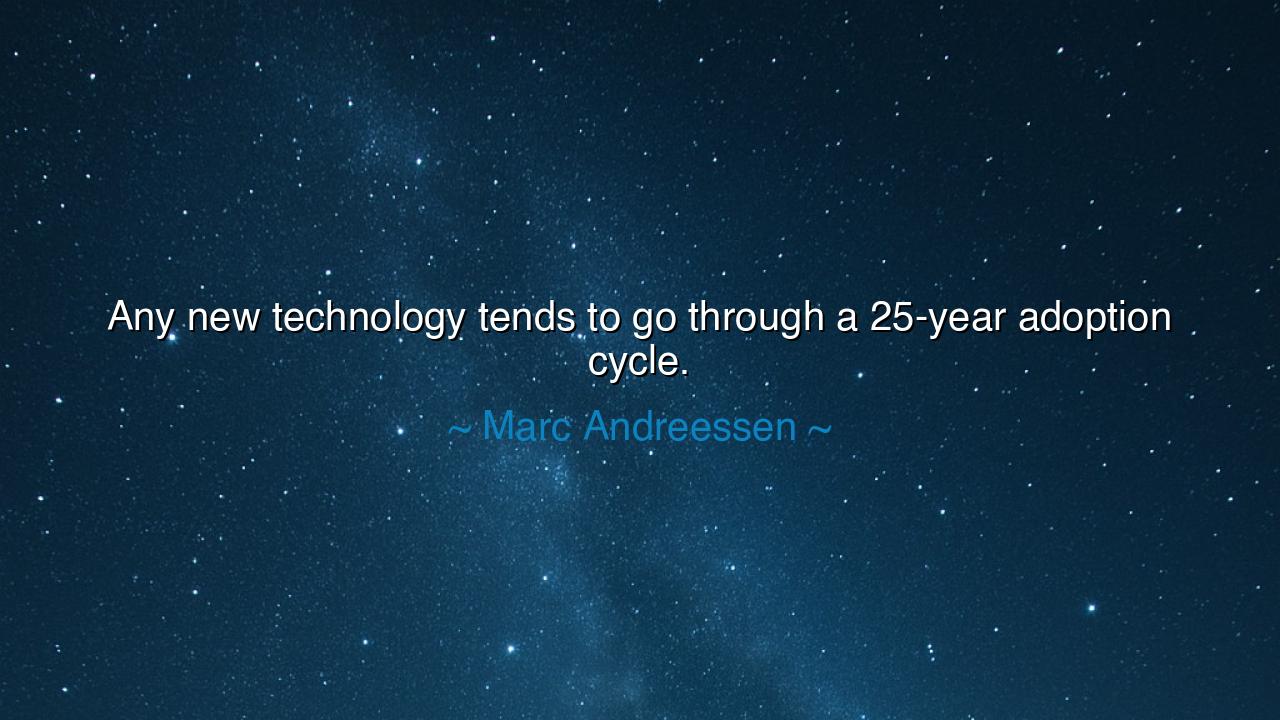
Any new technology tends to go through a 25-year adoption cycle.






Hear the words of Marc Andreessen, a seer of the digital age, who proclaimed: “Any new technology tends to go through a 25-year adoption cycle.” In these words lies a profound truth about the nature of human progress, for invention alone is not enough to change the world. The hammer, the plough, the printing press, the steam engine, the computer—each appeared as a spark of brilliance, but it was only through time, through years of trial, resistance, refinement, and acceptance, that they transformed the lives of the many. Thus, Andreessen speaks not of mere machines, but of the rhythm by which humanity learns to embrace the future.
The ancients understood the slowness of change, though they spoke in different language. When the alphabet was first created, it was not embraced by all. Scribes clung to memory and oral tradition, fearing that writing would weaken the mind. Centuries passed before letters became the foundation of civilization. The truth was not that writing was weak, but that humanity required time to adapt, to test, to integrate. This is the essence of the 25-year cycle: the long road from fear to familiarity, from suspicion to necessity.
Consider the story of electricity. When Benjamin Franklin flew his kite in the storm, and later when Edison brought forth the light bulb, the brilliance of the discovery was clear. But society did not transform overnight. For decades, electricity was seen as a curiosity, dangerous and impractical for homes. It was only after long years of building infrastructure, refining safety, and proving its worth that the world was lit by the glow of electric light. The cycle was not swift, but in its completion, it reshaped every corner of human life.
So it has been with the computer, the internet, and every great leap forward. The first computers were vast machines filling entire rooms, mocked by some as toys for scientists. The internet began as a network for researchers, not the beating heart of global commerce and communication that it is today. Each of these followed the pattern Andreessen described: invention, skepticism, gradual adoption, and finally, ubiquity. The 25-year cycle is not a law of physics, but a law of the human spirit—the time it takes for minds, hearts, and systems to adjust to the new reality.
The deeper meaning of this truth is that patience is as vital to progress as brilliance. The visionary may see the future, but the world must be taught to walk toward it, step by step. To invent is heroic, but to endure through decades of doubt and delay is equally heroic. The fruits of invention ripen not in the moment of discovery, but in the slow unfolding of adoption. Thus, Andreessen’s words remind us: the true test of a new technology is not its creation, but its survival through the seasons of time.
History warns us also of the cost of impatience. Many inventors who glimpsed the future grew bitter when their work was not embraced. Nikola Tesla dreamed of wireless power, but lived in obscurity, his visions unrecognized in his age. Others, too, have seen their inventions dismissed, only to be celebrated long after their deaths. The 25-year cycle is a call to endurance, for those who labor in the present often plant seeds for future generations, knowing they may not live to see the harvest.
The lesson for us, children of tomorrow, is clear: do not despise slow progress. If you create, understand that acceptance takes time. If you witness a new technology, do not dismiss it too quickly, for today’s curiosity may be tomorrow’s necessity. Cultivate patience, honor perseverance, and trust the long rhythm of change. Greatness is not only in the invention of tools, but in the steadfastness of those who nurture them until they bear fruit.
Thus let Andreessen’s words be carried forward as wisdom: “Any new technology tends to go through a 25-year adoption cycle.” In them is the reminder that progress is a marathon, not a sprint; that the future is born not in an instant, but through decades of labor and patience. Take this teaching into your heart: to build, to endure, to wait—and in due time, to see the world transformed.






AAdministratorAdministrator
Welcome, honored guests. Please leave a comment, we will respond soon